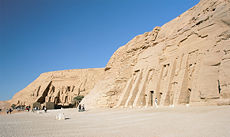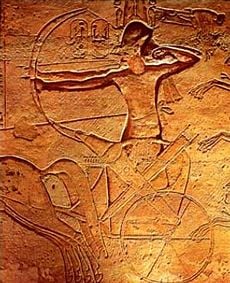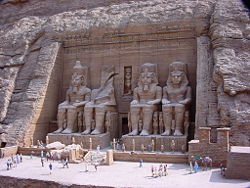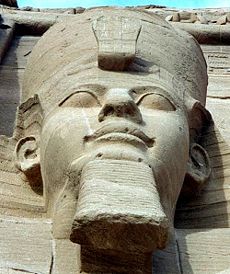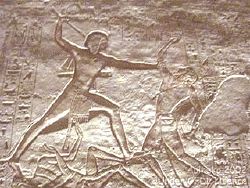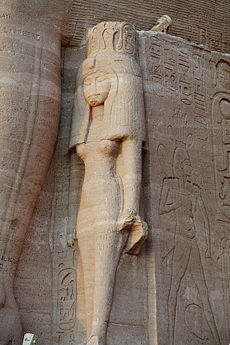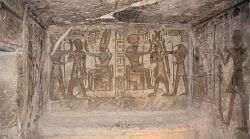Abu Simbel
| Nubian Monuments from Abu Simbel to Philae* | |
|---|---|
| UNESCO World Heritage Site | |
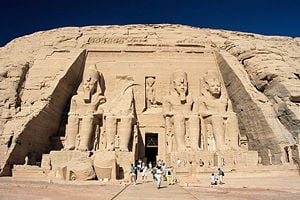
| |
| State Party | |
| Type | Cultural |
| Criteria | i, iii, vi |
| Reference | 88 |
| Region** | Arab States |
| Inscription history | |
| Inscription | 1979 (3rd Session) |
| * Name as inscribed on World Heritage List. ** Region as classified by UNESCO. | |
Abu Simbel (Arabic أبو سنبل or أبو سمبل) is an archaeological site comprising two massive rock temples in southern Egypt on the western bank of Lake Nasser about 190 miles southwest of Aswan. It is part of the UNESCO World Heritage Site known as the "Nubian Monuments."
The twin temples were originally carved out of the mountainside during the reign of Pharaoh Ramesses II in the thirteenth century B.C.E., as a lasting monument to himself and his queen Nefertari, to commemorate his alleged victory at the Battle of Kadesh, and to intimidate his Nubian neighbors.
Salvage of the temples was necessary to prevent them from being submerged during the creation of Lake Nasser, the massive artificial water reservoir formed after the building of the Aswan dam on the Nile River. The relocation operation began in 1964 and continued until 1968, on an artificial hill made from a domed structure, high above the Aswan dam reservoir. Abu Simbel remains one of Egypt's top tourist attractions.
History
Construction
Construction of the temple complex started circa 1284 B.C.E. and lasted for approximately 20 years, until 1264 B.C.E. Known as the "Temple of Ramesses, beloved by Amun," it was one of six rock temples erected in Nubia (today's northern Sudan), during the long reign of Ramesses. Their purpose was to impress Egypt's southern neighbors, and also to reinforce the status of Egyptian religion in the region.
Rediscovery
With the passing of time, the temples became covered by sand. Already by the sixth century B.C.E., sand covered the statues of the main temple up to one's knees. The temple was forgotten until 1813, when Swiss orientalist J. L. Burckhardt found the top frieze of the main temple. Burckhardt spoke of his discovery with Italian explorer Giovanni Belzoni, who traveled to the site, but was unable to dig out an entry to the temple. Belzoni returned in 1817, this time succeeding in his attempt to enter the complex. He took everything valuable and portable with him.
Tour guides at the site relate the legend that "Abu Simbel" was a young, local boy who guided these early re-discoverers to the site of the buried temple which he had seen from time to time in the shifting sands. Eventually, they named the complex after him.
Relocation
In 1959, an international donations campaign to save the monuments of Nubia began: the southernmost relics of this ancient civilization were under threat from the rising waters of the Nile due to the construction of the Aswan High Dam.
The salvage of the Abu Simbel temples began in 1964, costing some $80 million. Between 1964 and 1968, the entire site was cut into large blocks, dismantled, and reassembled in a new location — 213 feet higher and 656 feet back from the river, in what many consider one of the greatest feats of archaeological engineering. Here they were reassembled, in precisely the same orientation to the sun and each other, and covered with an artificial mountain. Most of the joins in the stone have now been filled by antiquity experts, but it is still possible to see where the blocks were cut on the inside of the temples.
Today, thousands of tourists visit the temples daily. Guarded convoys of buses and cars depart twice a day from Aswan, the nearest city. Many visitors also arrive by plane, at an airfield that was specially constructed for the temple complex.
Temples
The larger of the two temples is dedicated to Ra-Harakhty, Ptah, and Amun, Egypt's three state deities of the time, and features four large statues of Ramesses II in the facade. The smaller temple is dedicated to the goddess Hathor, personified by Nefertari, Ramesses's most beloved wife. (The pharaoh had some 200 wives and concubines).
The Great Temple
The Great Temple, which took approximately 20 years to build, was completed around year 24 of the reign of Ramesses the Great, which corresponds to 1265 B.C.E. It is generally considered the grandest of the temples commissioned during the reign of Ramesses II, and one of the most beautiful in Egypt.
Flanking the entrance are four colossal, 65.6-foot statues of the pharaoh with the double crown of Upper and Lower Egypt decorating the facade of the temple, which is 114.8 feet wide and is topped by a frieze with 22 baboons. The colossal statues were sculpted directly from the rock in which the temple was located before it was moved. Each statue represents Ramesses II, seated on a throne. The statue to the left of the entrance was damaged in an earthquake, leaving only the lower part of the statue still intact. The head and torso can still be seen at the statue's feet.
Beside the legs of the colossi, there are other statues no higher than the knees of the pharaoh. These depict Nefertari, Ramesses`s chief wife; the queen mother Mut-Tuy; his first two sons Amun-her-khepeshef, and Ramesses; and his first six daughters Bintanath, Baketmut, Nefertari, Meritamen, Nebettawy, and Isetnofret.
The entrance is crowned by a bas-relief representing two images of the king worshiping the falcon-headed Ra Harakhti, whose statue stands in a large niche. This god is holding the hieroglyph user and a feather in his right hand, while Ma'at, the goddess of truth and justice, in on his left. Another notable feature of the facade is a stele which records the marriage of Ramesses with a daughter of king Hattusili III, whose union sealed the peace between Egypt and the Hittites.
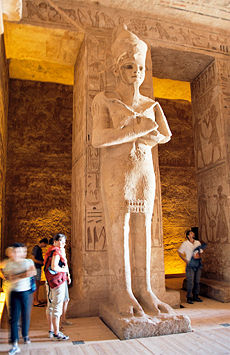
The inner part of the temple has the same triangular layout that most ancient Egyptian temples follow, with rooms decreasing in size from the entrance to the sanctuary. The temple is complex in structure and quite unusual because of its many side chambers. The hypostyle hall (sometimes also called pronaos) is 59-feet long and 54.8-feet wide and is supported by eight huge Osirid pillars depicting the deified Ramesses linked to the god Osiris, the god of the Underworld, to indicate the everlasting nature of the pharaoh. The colossal statues along the left-hand wall bear the white crown of Upper Egypt, while those on the opposite side are wearing the double crown of Upper and Lower Egypt.
Bas-reliefs on the walls of the pronaos depict battle scenes in the military campaigns waged by the ruler. Much of the imagery is given to the Battle of Kadesh, on the Orontes river in present-day Syria, in which the Egyptian king fought against the Hittites. The most famous relief shows the king on his chariot shooting arrows against his fleeing enemies, who are being taken prisoner. Other scenes show Egyptian victories in Libya and Nubia.
From the hypostyle hall, one enters the second pillared hall, which has four pillars decorated with beautiful scenes of offerings to the gods. There are depictions of Ramesses and Nefertari with the sacred boats of Amun and Ra-Harakhti. This hall gives access to a transverse vestibule in the middle of which is the entrance to the sanctuary. Here, on a black wall, are rock-cut sculptures of four seated figures: Ra Harakhti, the deified king Ramesses, and the gods Amun Ra and Ptah. Ra Harakhti, Amun Ra, and Ptah were the main divinities in that period and their cult centers were at Heliopolis, Thebes, and Memphis, respectively.
The axis of the temple was positioned by the ancient Egyptian architects in such a way that twice a year, on October 20 and February 20, rays of the sun would penetrate the sanctuary and illuminate the sculpture on the back wall, except for the statue of Ptah, the god connected with the Underworld, who always remained in darkness.
The smaller temple
The temple of Hathor and Nefertari, also known as the Small Temple, was built about 328 feet northeast of the temple of Ramesses II. This was, in fact, the first time in ancient Egyptian history that a temple was dedicated to a queen. The rock-cut facade is decorated with two groups of colossi that are separated by the large gateway. The statues, slightly more than 32 feet high, are of the king and his queen. On the other side of the portal are two statues of the king, wearing the white crown of Upper Egypt (south colossus) and the double crown (north colossus); these are flanked by statues of the queen and the king.
What is truly surprising is that for the only time in Egyptian art, statues of the king and his consort are equal in size. Traditionally, the statues of the queens stood next to those of the pharaoh, but were never taller than his knees. This exception to such a long-standing rule bears witness to the special importance attached to Nefertari by Ramesses, who went to Abu Simbel with his beloved wife in the 24th year of his reign. At the Great temple of the king, there are small statues of princes and princesses next to their parents. In this case they are positioned symmetrically: on the south side (at left as you face the gateway) are, from left to right, princes Meryatum and Meryre, princesses Meritamen and Henuttawy, and princes Rahirwenemef and Amun-her-khepeshef, while on the north side the same figures are in reverse order. The plan of the Small Temple is a simplified version of that of the Great Temple.
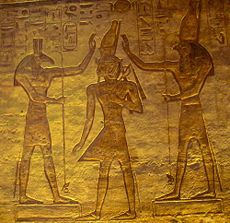
As in the larger temple dedicated to the king, the hypostyle hall or pronaos of the smaller, is supported by six pillars; in this case, however, they are not Osirid pillars depicting the king, but are decorated with scenes with the queen playing the sinistrum (an instrument sacred to the goddess Hathor), together with the gods Horus, Khnum, Khonsu, and Thoth, and the goddesses Hathor, Isis, Maat, Mut of Asher, Satis, and Taweret; in one scene Ramesses is presenting flowers or burning incense. The capitals of the pillars bear the face of the goddess Hathor; this type of column is known as Hathoric. The bas-reliefs in the pillared hall illustrate the deification of the king, the destruction of his enemies in the north and south (in this scenes the king is accompanied by his wife), and the queen making offerings to the goddess Hathor and Mut.
The hypostyle hall leads into a vestibule, access to which is given by three large doors. On the south and the north walls of this chamber there are two graceful and poetic bas-reliefs of the king and his consort presenting papyrus plants to Hathor, who is depicted as a cow on a boat sailing in a thicket of papyri. On the west wall, Ramesses II and Nefertari are depicted making offerings to god Horus and the divinities of the Cataracts - Satis, Anubis and Khnum.
The rock-cut sanctuary and the two side chambers are connected to the transverse vestibule and are aligned with the axis of the temple. Bas-reliefs on the side walls of the small sanctuary represent scenes of offerings to various gods made either by the pharaoh or the queen. On the back wall, which lies to the west along the axis of the temple, there is a niche in which Hathor, as a divine cow, seems to be coming out of the mountain: the goddess is depicted as the Mistress of the temple dedicated to her and to queen Nefertari, who is intimately linked to the goddess.
Worship at the temples
Each temple had its own priest that represented the king in daily religious ceremonies. In theory, the Pharaoh should be the only celebrant in daily religious ceremonies performed in different temples throughout Egypt. In reality, the high priest also played that role. To reach that position, an extensive education in art and science was necessary, like the one pharaoh had. Reading, writing, engineering, arithmetic, geometry, astronomy, space measurement, time calculations, were all part of this learning. The priests of Heliopolis, for example, became guardians of sacred knowledge and earned the reputation of wise men.
ReferencesISBN links support NWE through referral fees
- Ben-Jochannan, Yosef. Abu Simbel to Ghizeh: A Guidebook and Manual, Black Classic Press. 1989. ISBN 9780933121270
- Doss, L., & Besada, A. The Story of Abu Simbel, Longman International Education Division, 1973. ISBN 9780582761162
- Hawass, Zahi. The Mysteries of Abu Simbel: Ramesses II and the Temples of the Rising Sun, American University in Cairo Press, 2001. ISBN 9789774246234
- MacQuitty, Willaim. Abu Simbel, NY: Putnam's Sons, 1965. ASIN B000IVEOL2
External links
All links retrieved June 14, 2023.
- Abu Simbel. Sacred Places .
Credits
New World Encyclopedia writers and editors rewrote and completed the Wikipedia article in accordance with New World Encyclopedia standards. This article abides by terms of the Creative Commons CC-by-sa 3.0 License (CC-by-sa), which may be used and disseminated with proper attribution. Credit is due under the terms of this license that can reference both the New World Encyclopedia contributors and the selfless volunteer contributors of the Wikimedia Foundation. To cite this article click here for a list of acceptable citing formats.The history of earlier contributions by wikipedians is accessible to researchers here:
The history of this article since it was imported to New World Encyclopedia:
Note: Some restrictions may apply to use of individual images which are separately licensed.
